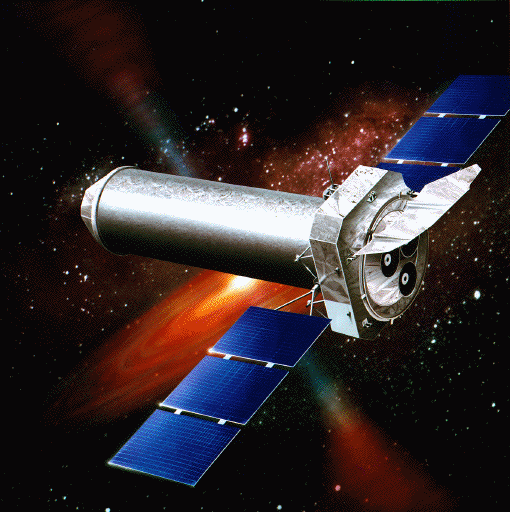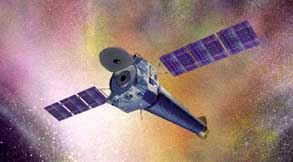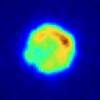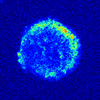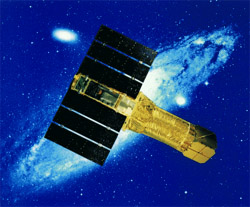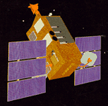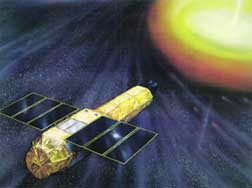About Constellation-X
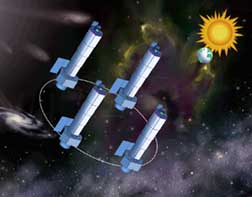
|
The Constellation-X Observatory will assist in putting together the
missing pieces to understanding the X-ray Universe. The observatory
consists of four X-ray telescopes or satellites that will detect a broader
range of X-ray wavelengths than any current technology, especially X-rays
at higher frequencies. Combining the observing power of four telescopes
means that the total X-ray effective collecting area is much larger than
that of previous telescopes. Constellation-X's total light collecting area
is 3 square meters, a hundred times greater than the finest current
instruments. The increased light gathering ability will allow
Constellation-X to observe extremely faint X-ray emitting sources within
our Galaxy and far beyond. Useful data from these faint sources will be
collected in hours instead of days or weeks.
|
Constellation-X will be launched near the end of the coming decade. Its
four satellites will orbit together in space about a few hundred miles
from each other, and will detect and collect X-ray photons (instead of
generating these photons like a medical X-ray machine). It will require
several rocket missions to launch the entire observatory. The point at
which the satellites will orbit is 1.5 million miles away from Earth where
both the Sun's and Earth's gravitational pull are equal.
What will Constellation-X Observe?
Constellation-X will obtain spectra of distant sources, including
supermassive black holes, X-ray binaries, galaxy clusters, supernova
remnants, and stellar coronae. A spectrum (the plural of spectra) is a
plot of the intensity of light at different frequencies (or equivalently,
at different wavelengths or energies - see our Introduction to Spectroscopy). With a larger
number of collected light photons, the resolution of spectroscopy
increases tremendously. Higher resolution means that the collected data
will be more quantitative. A high resolving power, for example, is
necessary to distinguish the lithium satellite lines from the overlapping
helium-like lines or transitions. Therefore, scientists will know exactly
what elements are in X-ray sources such as supernova remnants, as well as
their abundance, their density, and how fast they are moving. Spectra from
Constellation-X are like "the fingerprint of elements in far-away stars
and clouds of gas." High spectral resolution is essential to making unique
identifications (from emission lines).
Constellation-X will be able to focus on smaller areas, which will
automatically exclude picking up X-ray signals from the external medium of
hot gas or other nearby sources. Its ability to discriminate among
different X-ray wavelengths will be far better than any other X-ray
telescope.
What questions will Constellation-X answer?
"Constellation-X will be the next best thing to reaching out and touching
supernova remnants, black holes, clusters of galaxies, and dark matter."
What happens close to a black hole?
The observatory will be able to
measure the extreme gravitational force around a black hole. A black hole
is defined by a surface called the event horizon, where gravity is so
intense that nothing, not even light, can escape. Stellar matter is
crushed into a single point behind the event horizon. Around black holes,
interstellar gases move, heat up, and emit light energy in the form of
X-rays. Constellation-X will be able to zoom to within a few miles of the
event horizons of supermassive black holes in active galaxies outside our
own Milky Way and obtain spectra of the gas found there. The spectra will
be utilized to see the effects of how extreme gravity around a black hole
affects the composition, pressure, density, temperature, and velocity of
nearby gas. Scientists will eventually be able to collect quantitative
data regarding the formation and evolution of these black holes residing
in the centers of many (if not most) galaxies. For more information, see:
http://constellation.gsfc.nasa.gov/public/science/black_holes.html
Recycling: The law of the Universe?
From individual stars to clusters of
galaxies, the Universe is one big recycling machine. Constellation-X will
produce detailed measurements of the formation of elements between carbon
and zinc in stars, by observing supernova remnants. Galaxy Clusters are
the largest objects in the Universe. They are complex, multi-component
systems with hundreds of galaxies, hot gaseous intracluster medium, and
dark matter, all evolving together. Constellation-X will study the
chemical abundance of the intergalactic medium, and will also be able to
measure the mass and motion of gas in the cores of galaxies. The motion of
gases will be examined to determine if this gaseous motion is the cause of
galactic mergers. Once it is understood how galaxies evolve and merge, a
basis for understanding the structures of the Universe will perhaps
develop. For more information, see:
http://constellation.gsfc.nasa.gov/public/science/life_cycles.html
Is there any Matter missing from the Universe?
One of the biggest
mysteries in modern astronomy is "what holds clusters of galaxies
together?" While the earth holds the moon in place, what prevents galaxy
clusters from spreading apart? The gravitational pull from the gases
between the clusters is not strong enough. One major discovery made by
scientists is the fact that most of the mass of galaxies, clusters, and
the Universe is in the form of dark matter. Dark matter is in a form
whereby it is not directly detectable. Scientists, however, know that dark
matter exists by its strong gravitational effects. Even though dark matter
cannot be directly observed, the Constellation Observatory will be able to
map out its location. Perhaps the mystery of dark matter will begin to
unfold. For more information, see: http://constellation.gsfc.nasa.gov/public/science/dark_matter.html
|
